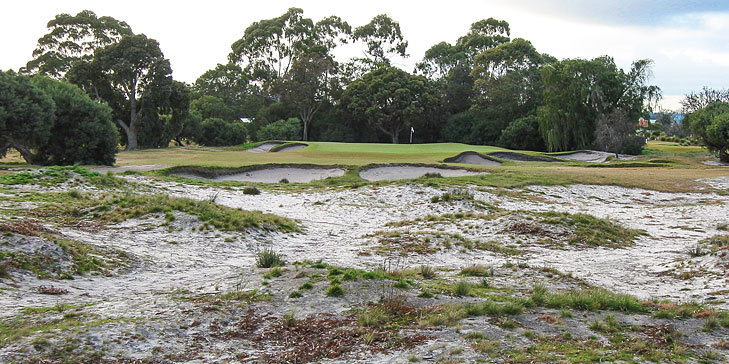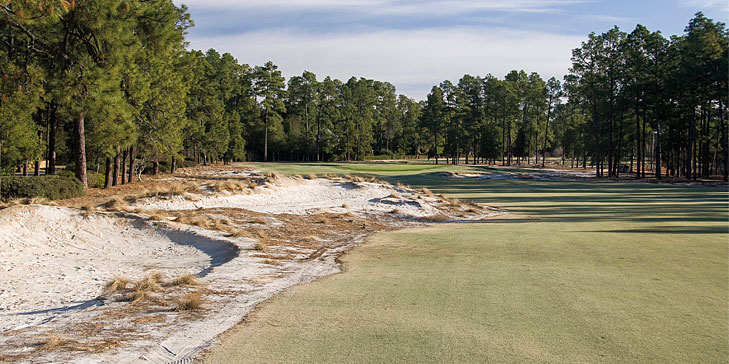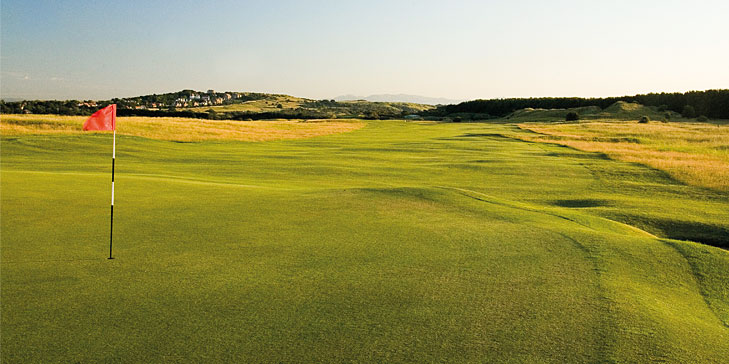This article was first published in Issue 39 of Golf Course Architecture
In any creative endeavour there is nothing more intimidating, or full of possibility, than a blank canvas. A flat, featureless site is the golf architect’s blank canvas and although the design challenges are clear the lack of natural features need not be a limitation.
History shows us that relatively flat sites can produce great golf courses. Carnoustie, Kingston Heath, and Garden City occupy flattish terrain in unspectacular settings yet they are considered among the world’s best. Even the Old Course and Muirfield are laid out over gentle sites with little change in elevation. These designs succeed by taking advantage of the freedom that comes with a blank canvas. Each course is famous for its routing, green contouring, and the shape and strategic placement of its hazards, features that don’t depend on dramatic topography. They also take full advantage of their sandy soil.
Sandy soil helps an architect overcome the challenges posed by a flat site in several ways. Most importantly, it allows the design to unfold without encountering drainage issues at every turn. Proper surface drainage is vital to healthy turf and good playing conditions.
 Exposed sand and native vegetation at Kingston Heath brings the flat terrain to life
Exposed sand and native vegetation at Kingston Heath brings the flat terrain to life
However, on many flat sites it would be almost impossible to achieve complete surface drainage without excessive earthmoving and catch basins to gather the water. This imposes serious limitations on the design and makes it very difficult to build a course that feels natural. On a flat sandy site, however, water will escape downwards through the porous soil, reducing the need for drainage related earthwork, pipes, and basins. This allows the architect to shape natural looking features that suit a hole’s strategy rather than its drainage requirements. Wrinkles, humps, and hollows fit perfectly into a flat landscape and create complex strategic challenges, but they are only practical where free draining soil keeps the low spots from staying wet after every rain.
Sandy terrain also offers firm and fast conditions, desirable on any course and especially important when trying to create interest and challenge on a flat site. Extra bounce and roll allows an architect to achieve maximum strategic impact from the subtle contours that fit best on flat terrain. When conditions are firm and fast, a small wrinkle or gentle tilt can dictate a hole’s entire strategy. Elevating a green slightly above fairway level or tipping it away from the player can create a significant and memorable challenge with minimum earth moving. So too can a subtle mound or hollow that steers shots off target. Contouring on this scale is ideal for golf because it can influence the bounce and lie of the ball without compromising visibility or walkability. When terrain is firm and fast, even small contours can have a significant strategic impact. This means that even a flat site has a lot of potential if the architect understands how to use terrain to shape the game.
 Pinehurst No. 2 shows how dramatic flat, sandy ground can be
Pinehurst No. 2 shows how dramatic flat, sandy ground can be
Sandy soil also makes it easier to create interesting and attractive hazards on flattish ground by giving the architect greater freedom with hazard style and location. Bunkers, and their surrounds, can be shaped to gather shots without worrying that they will gather water as well. This greatly increases a bunker’s sphere of influence and strategic value. In addition, bunkers can be carved directly into the natural sandy soil without adding drainage or importing bunker sand. This enhances their natural appearance and also reduces costs. Areas of exposed sand and sparse vegetation can also be incorporated into the design without worrying about them becoming muddy and unplayable. On a flat sandy site, simple, tightly mown hollows can also be an effective and natural-looking hazard. Firm and fast conditions help gather shots towards these features while offering a player numerous escape options. Recovery shots can be successfully played with a putter, sand wedge, or even a three wood. This kind of creative shotmaking keeps the game interesting and makes subtle hazards memorable. The recent restoration of Pinehurst No. 2 combined all of these elements to powerful effect, transforming a gentle sandy site into one of the world’s most interesting and visually striking golf courses.
Sandy soil gives an architect many tools to design a good golf course on flat ground, but how does the architect create a credible landscape from entirely manufactured features? The secret to success is not fighting the terrain, not trying to create anything that couldn’t have arisen naturally. Low profile earth moving and broad expanses of native grasses are examples of effective design features that fit comfortably on a flat site. Sandy soils mean less earthmoving is required to create an interesting golf course, making it much easier to shape features that are both believable and strategically significant. Gentler shaping along the lines of play makes it easier to blend the golf course features seamlessly into the surrounding landscape. Subtle shapes and smooth transitions help an entirely manufactured golf course fit comfortably into its surroundings.
 Long views across native grasses are a memorable part of playing Muirfield
Long views across native grasses are a memorable part of playing Muirfield
Sandy, nutrient-poor, soil also helps an architect create fine, wispy, and playable native areas. Native areas can have a big impact on flat terrain because they add texture and variety. Native grasses and plants can define holes, influence strategy, and mask earthmoving, all while enhancing the landscape. Sandy soil helps keep these areas lean and wispy, creating interest without the hassle of searching for lost balls. Skilfully placed native areas can turn the extreme openness of a flat site into a tremendous asset. One of golf’s most enjoyable experiences is looking across a sea of long grass waving in the breeze with flags and bunkers dotted across the landscape. That moment is made possible by flat terrain, native vegetation, and tastefully restrained earthmoving. Sandy soil allows those pieces to fit together.
Thinking about flat sites is especially relevant in modern golf course architecture because the golf courses of the future are unlikely to occupy premium land. Modern golf course developers and architects increasingly find themselves working with sites judged unsuitable for other uses. In many cases these are flat and relatively featureless, either naturally or as a consequence of the previous uses. Not all of these sites can produce a great golf course, but where there is sand there is hope. Golf was born on flat, sandy sites that society saw little use for at the time. Why shouldn’t similar sites play a significant role in golf’s future?